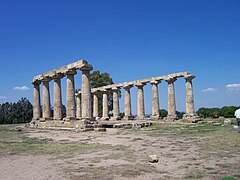
Magna Graecia
Magna Graecia[a] is a term that was used for the Greek-speaking areas of Southern Italy, in the present-day Italian regions of Calabria, Apulia, Basilicata, Campania and Sicily; these regions were extensively populated by Greek settlers starting from the 8th century BC.[2]
"Magna Grecia" redirects here. For the racehorse, see Magna Grecia (horse).
Magna Graecia
Μεγάλη Ἑλλάς (Ancient Greek)
8th century BC
city-states administered by the aristocracy
The settlements in this region, founded initially by their metropoleis (mother cities), eventually evolved into strong Greek city-states (poleis), functioning independently. The settlers brought with them their Hellenic civilization, and developed their own civilisation of the highest level,[3] due to the distance from the motherland and the influence of the indigenous peoples of southern Italy[3] which left a lasting imprint on Italy (such as in the culture of ancient Rome). They also influenced the native peoples, such as the Sicels and the Oenotrians, who became hellenised after they adopted the Greek culture as their own. In some fields such as architecture and urban planning, they sometimes surpassed the mother country.[4] The ancient inhabitants of Magna Graecia are called Italiotes and Siceliotes.
Remains of some of these Greek cities can be seen today, such as Neapolis ("New City", now Naples), Syrakousai (Syracuse), Akragas (Agrigento), Taras (Taranto), Rhegion (Reggio Calabria), and Kroton (Crotone). The most populous city of Magna Graecia was Sybaris (now Sibari) with an estimated population, from 600 BC to 510 BC, between 300,000 and 500,000.[1]
The government of city-states was usually an aristocracy[5] and the cities were often at war with each other.[6]
The Second Punic War put an end to the independence of the cities of Magna Graecia, which were annexed to the Roman Republic in 205 BC.[7]
From the motherland Greece, art, literature and philosophy decisively influenced the life of the colonies. In Magna Graecia much impetus was given to culture, especially in some cities such as Taras (now Taranto).[5] Noteworthy was the South Italian ancient Greek pottery, fabricated in Magna Graecia largely during the 4th century BC. The settlers of Magna Graecia had great successes in the Ancient Olympic Games in their homeland. Crotone's athletes won 18 titles in 25 Olympics.[8] Although many of the Greek inhabitants of Magna Graecia were entirely Latinized during the Middle Ages,[9] pockets of Greek culture and language remained and have survived to the present day. One example is the Griko people in Calabria (Bovesia) and Salento (Grecìa Salentina), some of whom still maintain their Greek language (Griko language) and customs.[10] The Griko language is the last living trace of the Greek elements that once formed Magna Graecia.[11]
List of Greek poleis[edit]
Mainland Italy[edit]
This is a list of the 22 poleis ("city-states") in Italy, according to Mogens Herman Hansen.[46] It does not list all the Hellenic settlements, only those organised around a polis structure.
Economy[edit]
In the cities of Magna Graecia, trade, agriculture and crafts developed. Initially oriented to the indigenous Italic populations, the trade was immediately an excellent channel of exchange with the Greeks of the motherland, even if today it is difficult to establish precisely the type of goods traded and the volume of these exchanges.[30]








